The cute mountain town of Samaipata has a laid-back atmosphere, charming hotels and trendy cafes. We adored this picturesque town set in the ‘Elbow of the Andes’ and think you will too.
As we arrived in town’s centre square we could already sense that Samaipata would be different from the other Bolivian towns we visited. Low roofed buildings painted with quirky designs line the outside of the square. Outdoor cafes were filled with tourists drinking coffee or having a late lunch. Others were browsing in the small craft shops. No one seems to be in a hurry in the laid-back town.
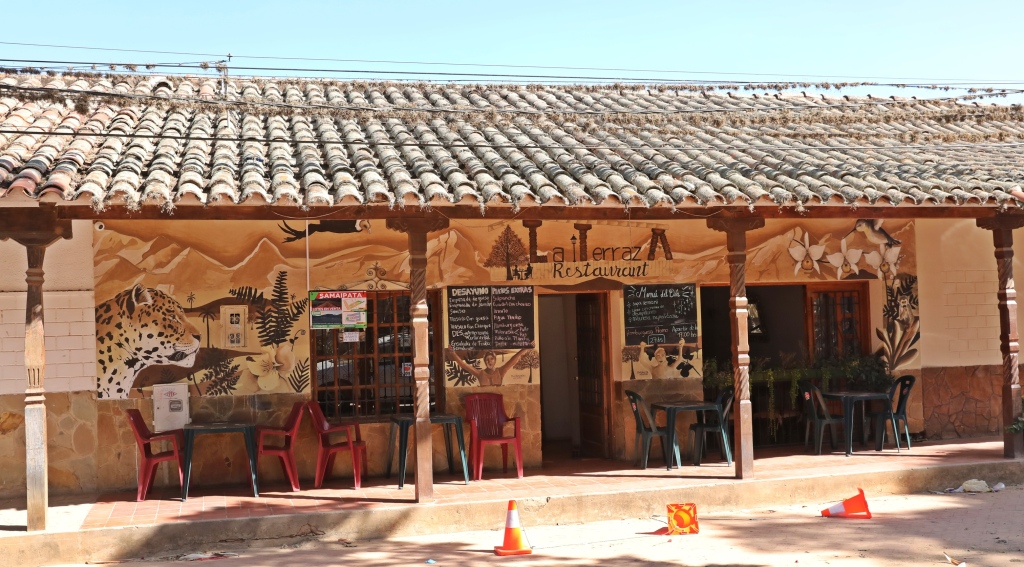


Samaipata is often referred to as Bolivia’s little Switzerland and we did find a little resemblance. Not only does it have a mountain town vibe but a few of the buildings are styled to look more like Swiss chalets than typical Bolivian construction. Apparently, quite a few Swiss and German expats live in Samaipata and built homes to remind them of their country.
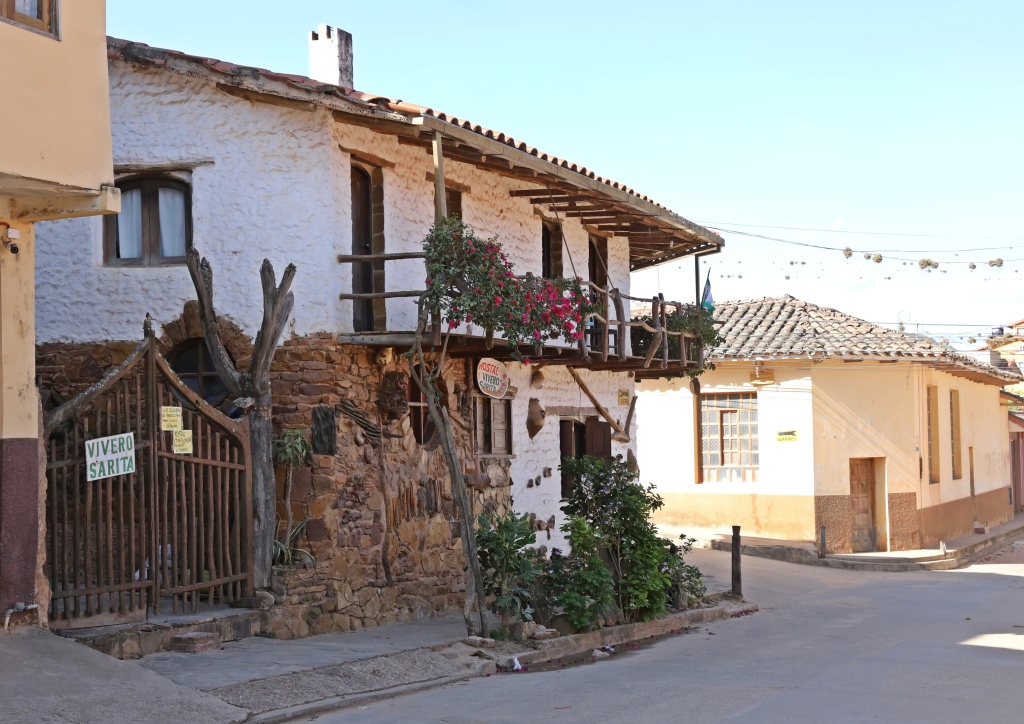
Samaipata is also unique because it has both international and Bolivian tourists. Unlike much of Bolivia, the nearby city of Santa Cruz de la Sierra is located at a low elevation and therefore can get quite hot. Conversely, Samaipata is at 1,600 m elevation and its cool, mountain temperatures make it a popular destination for residents of Santa Cruz when they want to escape the heat.


Its location on the eastern slopes of the Andes also means there are quite a few mountain activities. In the surrounding hills you can find many different hiking and biking trails as well as a mountain top pre-Incan ruin. We were able to visit a couple of spots during our short stay in Samaipata.
Las Cuervas
Although the name translates in English to ‘caves’ there aren’t any caves in Las Cuervas. Instead there are three small but pretty waterfalls that you can reach by short hiking trails.
It is located on private land where there are also cottages that are available to rent. A good hiking trail leads you past the cottages and into the forest to reach the first waterfall. It’s not very high, but has a small natural pool at its base. It’s a popular spot for families because it is a great place for kids to swim. It was quite chilly when we were there, so we didn’t swim in any of the three waterfalls.

From the first waterfall, follow the well-marked trail as it climbs a little higher through the forest. Waterfall two has a more wild, untamed look. Ferns and other plants cover the cliff making the water appear as if its searching between them for a passage down. It was our favourite of the three.


On the way up the hill to the 3rd waterfall a look-out lets you admire the surrounding mountain scenery. Far across the valley we could see the cliffs of the popular Amboró National Park. It is a large park with many hiking trails, but we didn’t have time to explore it.

You have to walk a little further up hill to reach the third waterfall, but it’s worth the effort. Dropping from a 20 m high cliff the last waterfall is taller than the other ones. With the open sky above you may think you’re at the top, but you’re not. A rough trail climbs even higher to reach a picturesque mountain cirque above.

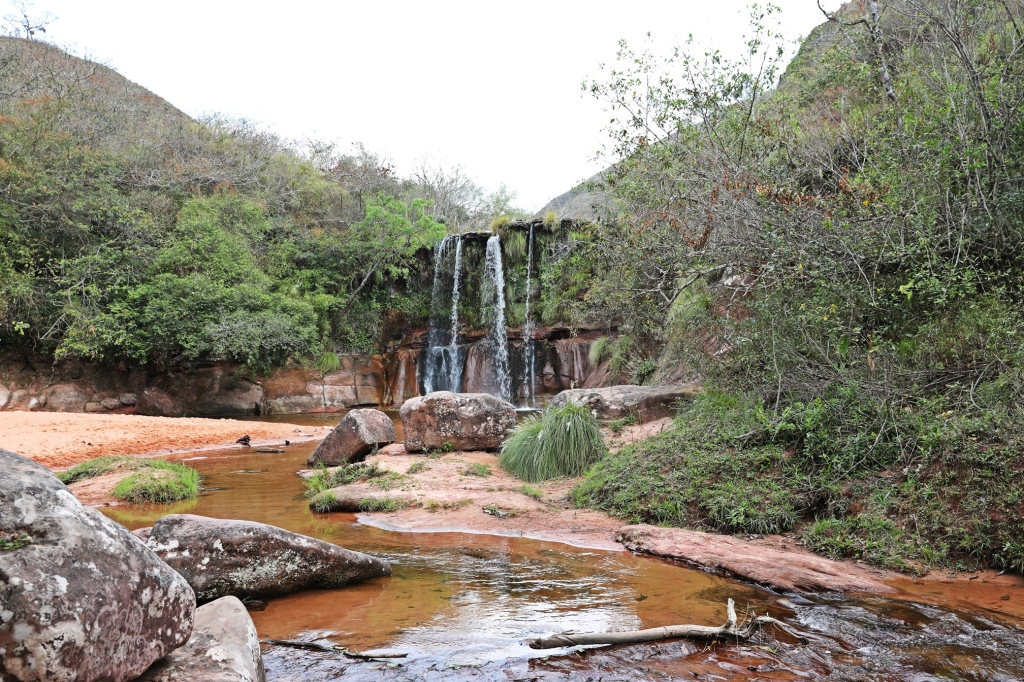


Entry fee into Las Cuervas is 20 Bolivianos.
Getting to Las Cuervas
There are a few tour agencies in town that offer day tours to the waterfalls, but it’s very easy to do on your own without a guide. Taxis can usually be found at the central plaza in Samaipata. They charge 100 Bolivianos to take you to the falls, wait for 2 hours and return to town. For a combined price you can also have them take you to El Fuerte (below) on the same trip. The ‘taxi’ that took us may have been the worst car we’ve ever been in. All that was left of the driver’s seat was the wire seat frame. None of the doors could open from the inside and you needed two hands and a lot of force to roll down the windows. We did make it to the falls and back despite the bald tires.
El Fuerte
Not far from town is a small historical site with pre-Incan ruins. Although the name translates in English to ‘fort’, El Fuerte was actually the site of a temple.
The temple ruins are located on the top of a mountain. On the walk to reach it we passed terraced farms and interesting vegetation growing right out of the mountain walls.


Once we reached the entrance to El Fuerte we could see the temple remains on a rock high above. Over 2,200 years ago the indigenous Chané people carved a temple into a large rock. Not much is known about their use of the temple or any of their other buildings on the site.
From the temple there is a lovely view of the surrounding mountains. It makes you wonder if the view was part of the reason this spot was originally chosen.

In the 16th century the Incas used the temple and the land around it. They expanded the temple by cutting niches into the side of the rock and adding buildings around the border. Researchers believe that some of the buildings were used for sacrifices. Not much is left of the temple today, but you can see some of the niches and the remains of a few buildings.

Spread across the green meadow below the temple you can visit the remains of a small Incan village. There are partial walls of homes, storage facilities and meeting halls.
Eventually the Spanish controlled the area and used it as a fort resulting in the name El Fuerte. They also built a small village in this same area, but there are no remains of those buildings. The Spanish eventually moved to Samaipata and the area was abandoned and forgotten. It’s not a large or well-preserved site but is worth a visit if you are in Samaipata.


Entry to El Fuerte is 50 Bolivianos and includes admission to the museum in town.
Getting to El Fuerte
The turn off to El Fuerte is 4 km from the edge of Samaipata, but the site is another 5 km up the mountain road. For 100 Bolivianos, taxis will take you to the site, wait for 2 hours and take you back to town. For an extra fee you can include it with a trip to Las Cuervas.
Ignore the location given on Google Maps and Maps.Me. We made the mistake of having our taxi drop us off on the highway at the turn-off because these maps show the site to be only 1.5 km from the highway. They are wrong. It’s actually located 5 km up the road, on the top of the mountain.
Getting to Samaipata
The closest city to Samaipata is Santa Cruz de la Sierra. Mini buses leave Santa Cruz from Salida a Samaipata Estrellita, one block from Av. Grigota & 2nd Ring Road. The fee is 30 Bolivianos and the bus leaves when it is full. The drive takes 3 hours. There are also night buses from Sucre and Cochabamba to Samaipata.
Where to stay and eat in Samaipata
Unlike many Bolivian towns, Samaipata is ready for tourists. There are many good quality budget hotels and guest houses as well as tourist friendly restaurants in the few blocks surrounding the main plaza. You don’t need to book a room in advance and most do not have on-line booking. We were able to easily find accommodation at Hotel Casa Blanca when we arrived. It was clean, comfortable and the fee (175 Bolivianos) included a great breakfast.
Santa Cruz de la Sierra
The nearest city to access Samaipata is Santa Cruz de la Sierra (called Santa Cruz). There’s not a lot to see in the city, so it probably shouldn’t be your primary destination. However, we were able to find enough things to do in Santa Cruz to see to keep us busy for a day.
Santa Cruz is considered the financial capital of Bolivia, but most of its buildings were poorly maintained. We did see a few lovely colonial buildings downtown, but the majority of the buildings in the city are not in good condition.
With its low elevation of 416 m, it quite hot in Santa Cruz. The one thing that we did enjoy about most of the downtown buildings is that they have colonnades. These covered sidewalks are a great way to provide shelter from the hot sun.
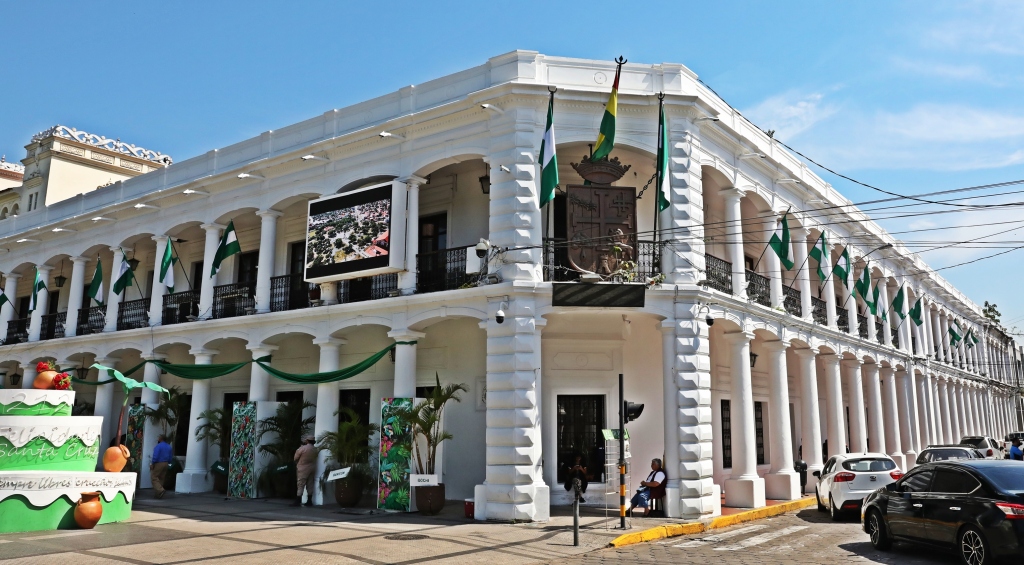

Plaza 24 de Septiembre is a large square in the centre of town. It’s filled with tall palm trees that provide much needed shade. On the side of the square is Igelsia Basilica Menor de San Lorenzo. This large brick church has two tall bell towers bookending the front entrance. The side of the church has detailed brick work and is actually nicer than the front. During the week it’s possible to climb to the top of one of the bell towers for a view of the city, but we arrived after it had closed for the weekend.




The square was busy with locals during the day but at night it seemed that it was the place to be. Families came for ice-cream and teenagers were hanging out with their friends. Most of Santa Cruz seemed to be in the square at night.

Something different in Santa Cruz than other Bolivian cities is the street art. If you walk around the streets surrounding the plaza you can find some great displays of colourful art.


We visited the botanical gardens on the outskirts of town, but it was a huge disappointment. The best part was the large display of bonsai trees near the entrance. This gave us hope for what was coming. We walked through much of the site and spotted a few different birds and some interesting plants, but rather than an botanical garden it was mostly an overgrown forest. Admission is free though so it’s difficult to complain.



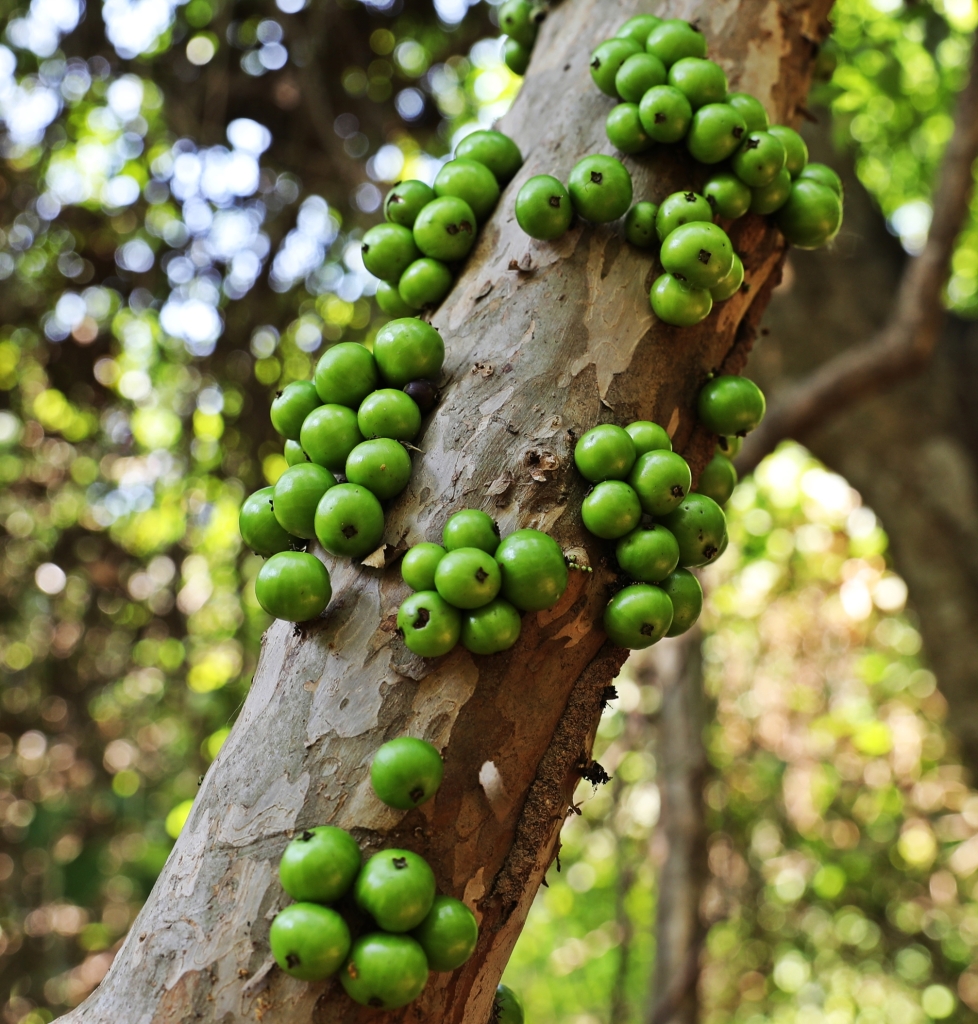
Getting to Santa Cruz
This major city has excellent access by both bus and by air from most other Bolivian cities. Located close to the border with Brazil, there are a few buses going to the nearest Bolivian border towns. We took a bus to San Matias and then took a taxi all the way to Cáceres (300 Bolivianos). If you go this way there is no border station on the Brazilian side but you do have to report to the Federal Police station in the nearest city of Cáceres. If you go through the more popular border crossing in Puerto Suárez apparently you can walk across the border and find buses in the Brazilian city of Corumbá.
Where to eat and stay in Santa Cruz
The city is not a primary tourist destination but there are several hotels and restaurants downtown. Try to stay near Plaza 24 de Septiembre for the most comfortable hotels and best restaurants.
To read about our other adventures in Bolivia click here.
Coming Next – Jesuit Missions of Chiquitania in Bolivia
For pictures from other blogs go to Gallery at monkeystale.ca
To read about more of our adventures go to Destinations.
If you like what you read, please comment or share (with credit) using the links below.
Those waterfalls look so primordial and inviting…
LikeLiked by 1 person
Yes they were, except for the chill in the mountain air, we would have swam in them 🙂
LikeLiked by 1 person
The architecture, the scenery, the waterfalls and all so overwhelmingly lovely. I’m most attracted to the ancient, archaeological sites.
LikeLiked by 1 person
The site was quite different from other Inca sites we’ve seen, but too bad there wasn’t much left to it.
LikeLiked by 1 person
Wow! Wow! Among all the beauty, I can’t help but love that iron work with the plant and 1st waterfall!!
LikeLiked by 1 person
I know that window with the cactus was so unusual. I love it too 🙂
LikeLike
I need to replicate that somewhere in my life to see every day😀
LikeLiked by 1 person
Oh the photos are geogeous and idyllic. What a fabulous area to visit. I enjoyed.💖
LikeLiked by 1 person
Thank you!
LikeLiked by 1 person
Samaipata definitely looks like the sort of town I’d like to linger in for a while, and I love the street art in Santa Cruz!
LikeLiked by 1 person
The street art was a nice surprise, it’s not very common in Bolivia. Thanks for your comments Sarah, Maggie
LikeLiked by 2 people
I’m very much enjoying this tour of some of the lesser known places in Bolivia!
LikeLiked by 2 people
Thanks 🙂
LikeLiked by 1 person
That looks a nice place to spend some time in! 🙂
LikeLiked by 1 person
It was! 🙂
LikeLiked by 1 person
🙂
LikeLike
Such an interesting area. There is so much variety in both the landscape and the culture. I am enjoying your travels there.
LikeLiked by 1 person
Thanks, Bolivia is not that large, but it is very diverse. Thanks for reading and commenting 🙂 Maggie
LikeLiked by 1 person
Santa Cruz was at least previously the cocaine capital with daily flights to Miami. We were surprised by all the Porsches there. We were also surprised by the numerous Mennonites in the area. Suppose you are headed to Brazil on what was previously called the “Cocaine Train” or the “Death Train”, but I imagine that they have cleaned up their act in the meantime.
LikeLiked by 1 person
Haha, we didn’t see any Porsches or many rich areas and I didn’t know about the cocaine routes! We did see a few Mennonites though, the stand out quite a bit 😉
LikeLiked by 1 person
I very much love the colourful street art in Santa Cruz – I believe that it is through art that we get to communicate our ideas, express our emotions, and effectively connect with others. Thanks for sharing and have a good day 🙂 Aiva xx
LikeLiked by 1 person
Yes that’s true, there’s not a lot of street art in Bolivia, so it was nice to see in Santa Cruz. Thanks for taking the time to comment Aiva, Maggie
LikeLiked by 1 person
It’s amazing, I love all the colours and warmth in the city, and the waterfalls look like a great way of getting out in to nature. And are they apples growing off the trunk of the tree in the botanical gardens?
LikeLiked by 1 person
We’re not sure what they were. They were only the size of berries, and we thought probably not edible, but who knows 🙂 Maggie
LikeLike
The waterfall hike and Samaipata look fabulous, though I can’t figure out why a Swiss person would want to live anywhere but Switzerland, 😉
LikeLiked by 1 person
Haha, well it’s a LOT cheaper to live in Bolivia I guess.
LikeLiked by 1 person
Looks awesome. Still need to visit Bolivia. Santa Cruz looks like am interesting place to check out.
LikeLiked by 1 person
We really loved Bolivia, so much to see! Thanks for reading and commenting Erik! Maggie
LikeLike
Another fabulous share with plenty of information and tempting pictures.
LikeLiked by 1 person
Thank you!
LikeLike
The landscape in Samaipata looks so pretty with all those waterfalls and mountains. It’s wild how different the vegetation is in South America compared to what we have back home in Canada.
LikeLike
You seem to specialize in scary rides in foreign countries! 🙂 That’s a weird takeaway from this post about lovely mountain towns, and yes, I did enjoy all those photos and descriptions also!
LikeLiked by 1 person
Haha we seem to find them don’t we!
LikeLiked by 1 person
I don’t think I’ll ever get to Bolivia, but your stories have made the idea tempting!
LikeLiked by 1 person
😊
LikeLiked by 1 person
Samaipata looks like a charming place to visit and it offers such wonderful nature hikes and walks. I like the street art in Santa Cruz. Shame that the botanical garden was a let down.
LikeLiked by 1 person
Samaipata was exactly what we needed at exactly the right time, fresh mountain air, a small town easiness and most of all good restaurants. From everything there it was such a lot down to see the Botanical Gardens. It was the stark reminder that we were in a 3rd world country.
LikeLiked by 1 person
The waterfalls, hikes, and terraced vineyards all look lovely. Stunning photos as usual!
LikeLiked by 1 person
Thank you!
LikeLiked by 1 person
It’s amusing when the names don’t match what’s there! Although, I wonder how much has to do with local knowledge and history
LikeLiked by 1 person
I know it was so funny. The names were most likely made centuries ago by the Spanish and never changed to reflect reality. 😊
LikeLiked by 1 person
What a lovely town! I love the mix of architecture styles and to have those beautiful mountains and waterfalls close by is a bonus 🙂
LikeLiked by 1 person
It’s the perfect little mountain town 😊
LikeLiked by 1 person
El Fuerte looks so interesting with the remnant of the Chané temple and those niches carved out by the Incas. It’s the kind of place I’d love to see when I travel. It seems like Bolivia has all these overlooked ancient sites which are actually worth seeing.
LikeLiked by 1 person
Yes there are quite a few small Incan and pre-Incan sites in Bolivia but it’s really hard to find information about them. The niches in this one were very unusual as far as I’ve seen, and fascinating to learn about.
LikeLiked by 1 person
Great photos I like the one with the plant going on the window. I would like one day to visit that country.
LikeLiked by 1 person
Thank you, the cactus in the window were quirky and fun, we loved it too 😊 Thanks for taking the time to comment Melodie. Maggie
LikeLike
Another excellent guide that conveys that richness and vibrancy of the location. Thank-you!
LikeLiked by 1 person
Thank you so much!
LikeLike
We really loved our time there in Bolivia. You are so excited to be there so much to see and do. But those waterfalls were so interesting. Thanks for sharing this. Anita
LikeLike
You certainly don’t sit around, twiddling your thumbs and swilling cervesa on your trips – it seems like you see everything! No point in wasting an opportunity, eh?
LikeLike
One of the many things which you’ve really sold well about Bolivia is the variety – so many different types of destination and so many different types of day to have. Fabulous.
LikeLiked by 1 person
I know, we were continuously so surprised at how diverse the small country is. And each area is fascinating! 😊
LikeLiked by 1 person
Another outstanding post about a beautiful place, full of information, and great images
LikeLiked by 1 person
Thank you 🙂
LikeLiked by 1 person
You’re highly welcome 🙏❣️🙏
LikeLike
Adding these places to our list. This is totally up our alley. Thanks again!
LikeLiked by 1 person
Samaipata is really cute. If you’ll have your own car there are some nice Fincas that you can stay in. If you have to take taxis I’m not sure how it would work. Some are listed on Booking.
LikeLike
Each of these places in Bolivia has such a different vibe. Love the murals at Santa Cruz, and of course those waterfalls, each having several paths down the rocks.
LikeLiked by 1 person
We were so surprised at how diverse the small country was. Samaipata really felt different than the rest of Bolivia. Thanks for your comments Ruth, Maggie
LikeLiked by 1 person
What a beautiful place – those waterfalls!
LikeLike
A good place to visit! Thanks for sharing awesome pics.
LikeLiked by 1 person
Thank you 🙂
LikeLike
❄🧊⛄🌿🎄🕯🤍🕊🎁🎉🥂✨
LikeLike